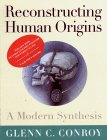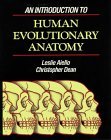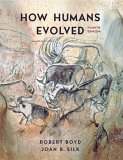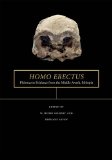
|
Human Origins: The Fossil Record
An up-to-date pictorial review of the major fossil finds in the world! This updated, introductory guidebook to the fossil record of prehuman and human evolution presents detailed drawings of complete or nearly complete specimens representative of particular grades of evolution. Each drawing (usually shown at 75 percent of original size) is accompanied by appropriate information, including geographical location, approximate age, and general description. Descriptions include information on the context of the discovery and summary anatomical details. The detailed drawings in this highly regarded volume make it an excellent sourcebook for use in departments with limited fossil cast collections. |

|
Encyclopedia of Human Evolution and Prehistory
This is a very readable, thorough reference source covering every aspect of human evolution and prehistory. The scientific facts, theories, and philosophies pertaining to evolution are presented skillfully and understandably. The numerous illustrations, diagrams, and charts aid in the understanding of the text. The biographical entries are complete, providing the individuals' contributions to the study of evolution and related fields. The descriptions of archaeological sites are well written. Many articles have been greatly revised, making them much more readable and incorporating all of the new findings that have been reported in the last 10 years.This encyclopedia continues to be the most inclusive and authoritative source of information on anthropology and human evolution. It is an essential source for all academic libraries and large public libraries. |

|
The Cambridge Dictionary of Human Biology and Evolution
Packed with 13000 descriptions of terms, specimens, sites and names, this invaluable research and study tool covers a broad range of subjects including human biology, physical anthropology, primatology, physiology, genetics, paleontology and zoology. The volume also includes over 1000 word roots, taxonomies and reference tables for extinct, recent and extant primates, and illustrations of landmarks, bones and muscles. It is essential for students, researchers, and anyone with an interest in human biology or evolution. |

|
An Introduction to Human Evolutionary Anatomy
A highly innovative hybrid between textbook and extended review, that will be an essential resource for advanced undergraduates and researchers in any related field...Aiello and Dean have performed a major feat in bringing together in the compass of one volume such a mass of information. A couple of hours with Aiello and Dean will save the researcher days and weeks in the library. I believe it will come to be regarded as one of the most important resources for anyone framing a new research project in early hominid studies. |

|
How Humans Evolved
How Humans Evolved uses the broad perspective of behavioral ecology, drawing on Robert Boyd's expertise in evolutionary theory and Joan Silk's specialty in primate behavior in a uniquely integrative text |
|
The Human Fossil Record: Terminology and Craniodental Morphology
of Genus Homo (Europe)
This landmark publication
provides the first comprehensive site-by-site compendium of uniform descriptions
and original photographs of all fossils that document the human evolutionary
past. Compiled by two of the most renowned experts in the field, this
book offers morphological descriptions of the genus Homo in Europe. |
|
Neanderthals and Modern Humans: An Ecological and Evolutionary Perspective
The Neanderthals were a people native to Europe during the Pleistocene period, who became extinct between forty and thirty thousand years ago. Challenging the commonly held view that extinction was caused by the arrival of our ancestors, Clive Finlayson provides evidence that their extinction actually occurred because the Neanderthals could not adapt fast enough to changing ecological and environmental conditions, not their relationship with modern humans. |
|
Homo erectus: Pleistocene Evidence from the Middle Awash, Ethiopia
This volume, the first in a series devoted to the paleoanthropological resources of the Middle Awash Valley of Ethiopia, studies Homo erectus, a close relative of Homo sapiens. Written by a team of highly regarded scholars, this book provides the first detailed descriptions, photographs, and analysis of the fossil vertebrates--from elephants and hyenas to humans--from the Daka Member of the Bouri Formation of the Afar, a place renowned for an abundant and lengthy record of human ancestors. These fossils contribute to our understanding human evolution, and the associated fauna provide new information about the distribution and variability of Pleistocene mammals in eastern Africa. The contributors are all active researchers who worked on the paleontology and geology of these unique deposits. Here they have combined their disparate efforts into a single volume, making the original research results accessible to both the specialist and the general reader. The volume synthesizes environmental backdrop and anatomical detail to open an unparalleled window on the African Pleistocene and its inhabitants. |













